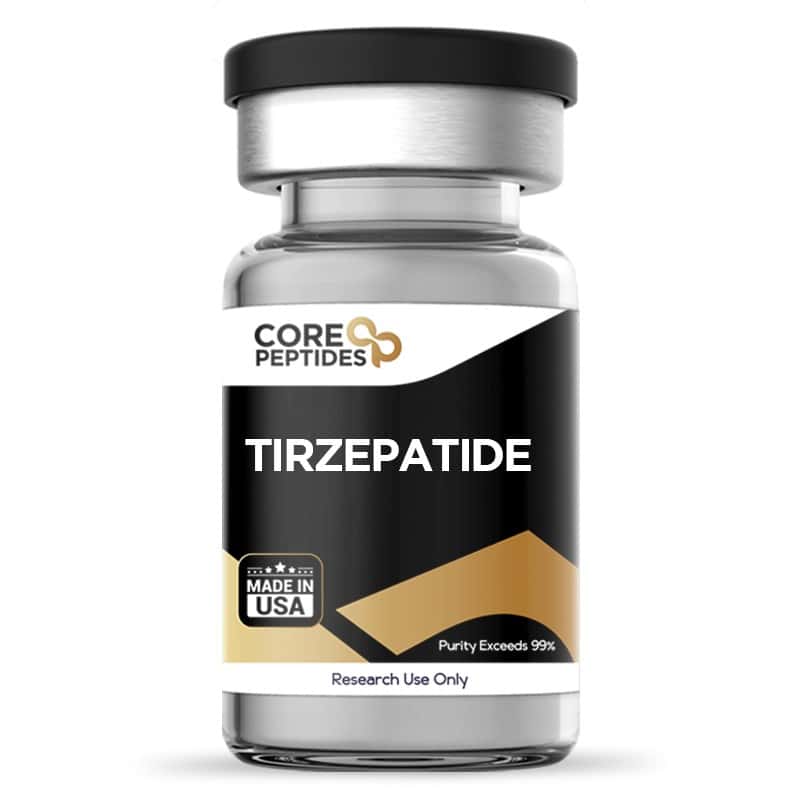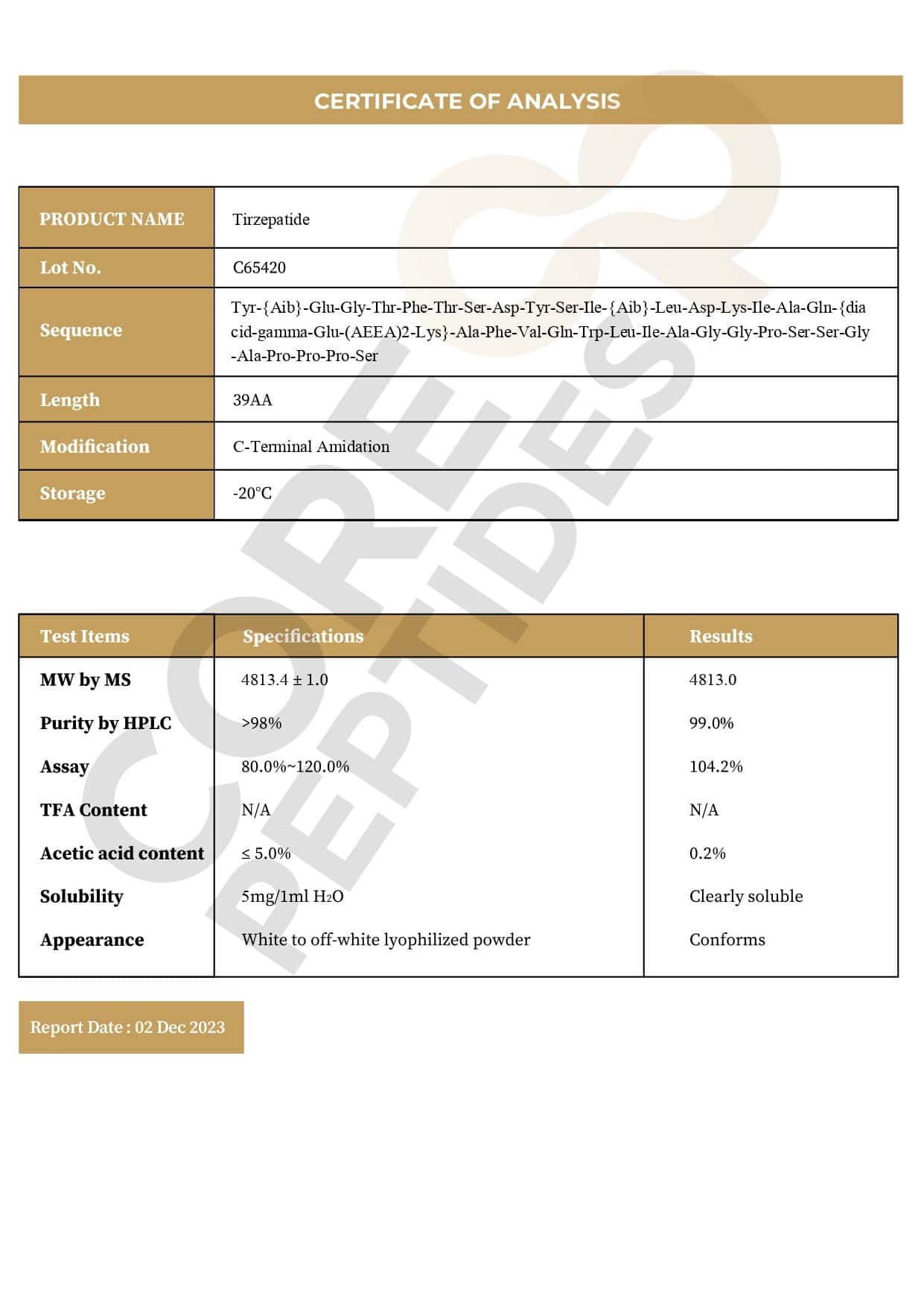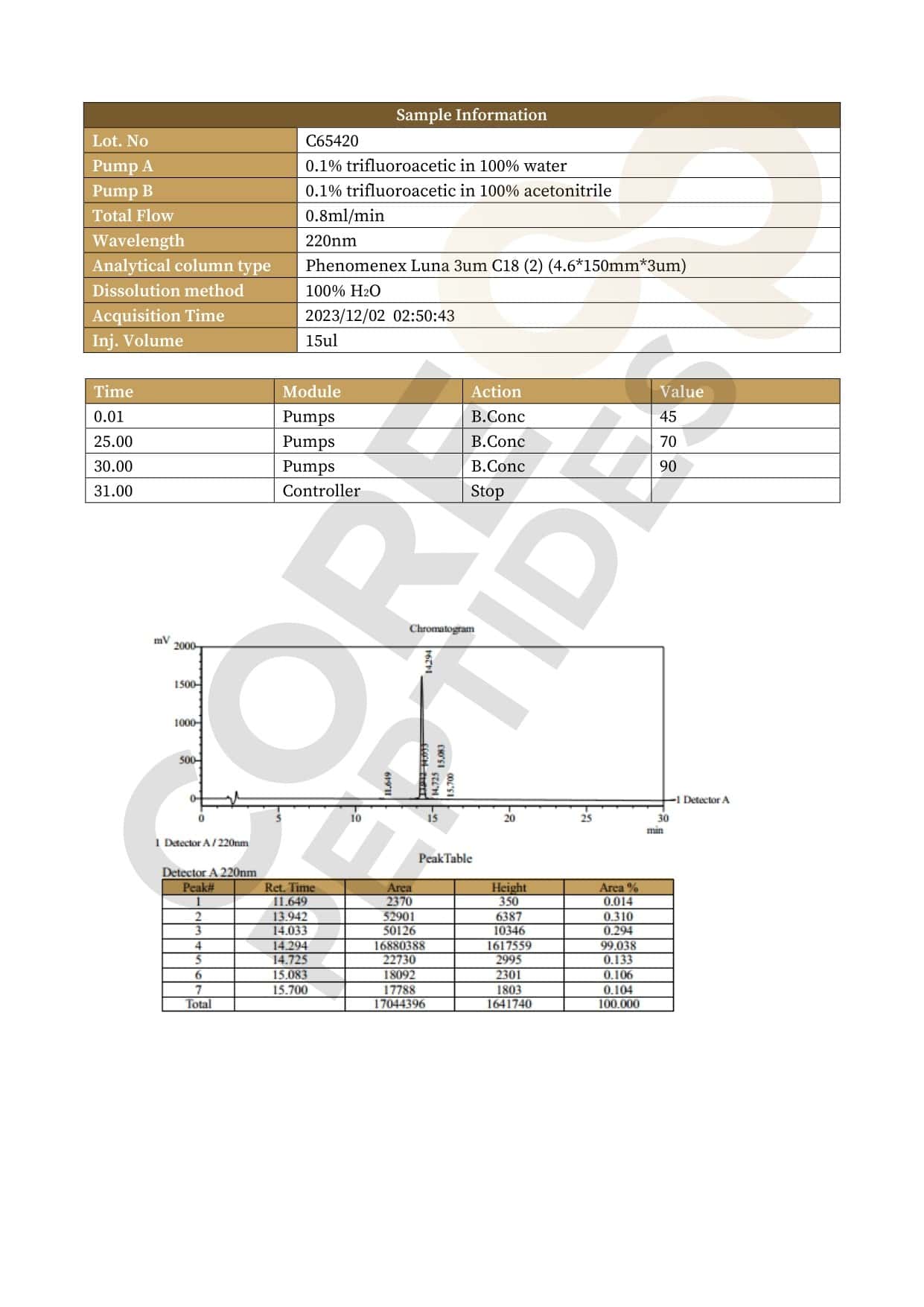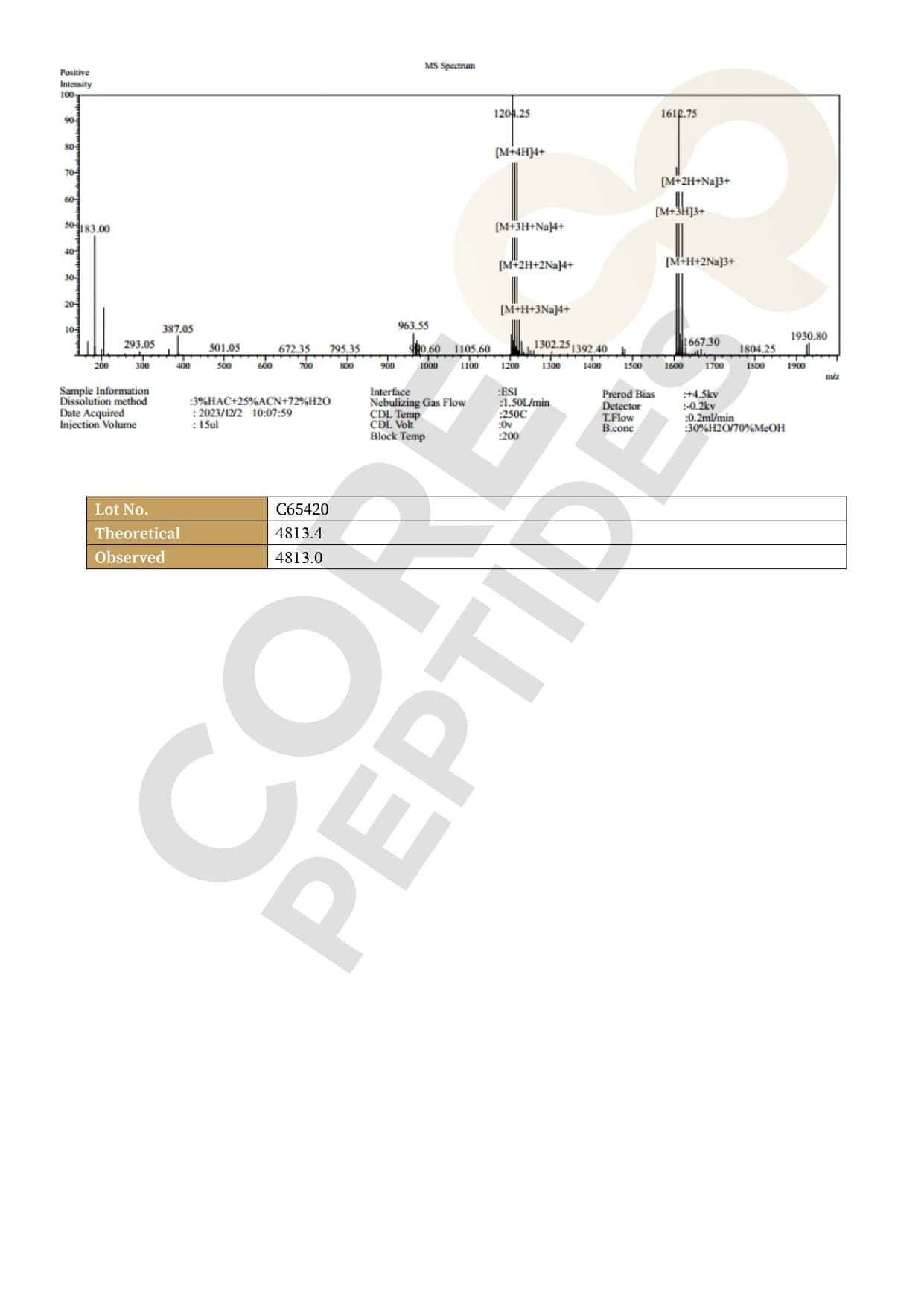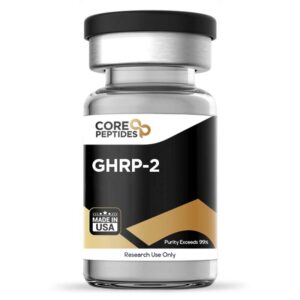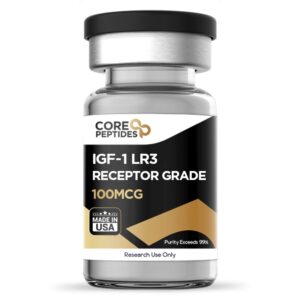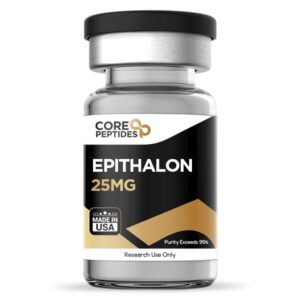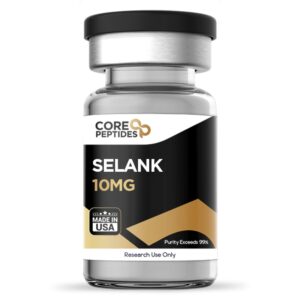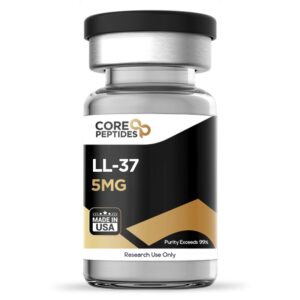Tirzepatide (5mg / 10mg)
$139.00 – $194.00
Size: 5mg / 10mg
Contents: Tirzepatide
Form: Lyophilized powder
Purity: >99%
SKU: P-Tirzepatide
FREE Shipping on $200+ orders
FREE Bacteriostatic Water (30ml) on $200+ orders
Discount per Quantity
| Quantity | Discount | Price |
|---|---|---|
| 5 - 8 | 5% | $132.05 – $184.30 |
| 9 + | 10% | $125.10 – $174.60 |
Tirzepatide Peptide
Tirzepatide is a novel peptide, widely studied for its potential to improve glycemic control and promote weight loss in individuals with type 2 diabetes. This peptide is a dual agonist of the glucagon-like peptide-1 (GLP-1) and glucose-dependent insulinotropic polypeptide (GIP) receptors, which play critical roles in glucose homeostasis and appetite regulation.
Tirzepatide is a peptide hormone that has the potential to act as an agonist at both the gastric inhibitory polypeptide (GIP) receptor and the glucagon-like peptide-1 (GLP-1) receptor. A linear polypeptide made up of 39 amino acids, Tirzepatide has been chemically modified by lipidation to potentially improve its uptake into cells and its stability to metabolism.(1) The action of Tirzepatide (GIP) peptide is apparently mediated through activation of the GLP-1 and GIP receptors, possibly leading to enhanced insulin secretion, glucose uptake, and satiety signaling.
Chemical Makeup(2)
Molecular Formula: C225H348N48O68
Molecular Weight: 4813 g/mol
Other known titles: GTPL11429, P1206
Research and Clinical Studies
Tirzepatide Peptide and Diabetes
Tirzepatide may exhibit synergistic agonistic potnetial on the GLP-1 and GIP receptors, making Tirzepatide potentially more impactful than strict GLP-1R agonists. Researchers have suggested the affinity of Tirzepatide for GIP-R to be greater than its affinity for GLP-1R. Glucose-dependent insulinotropic polypeptide, or GIP, is naturally produced in the small intestine. Binding to GIP-R inhibits gastric acid secretion and gastrin release while triggering insulin release. GLP-1R is present in beta cells and neurons in the brain, and GLP-1R activation stimulates insulin synthesis and release, thereby reducing appetite. Additionally, GLP-1R activation increases beta cell density in the pancreas by enhancing bcl-2 gene expression and reducing apoptosis, ultimately increasing insulin levels.(3)
Research indicates that Tirzepatide may act identically to GIP at GIP-R, but its activity at GLP-1R appears to favor cAMP production over β-arrestin recruitment. This difference in activity from endogenous GLP-1 leads to enhanced GLP-1R activity without increasing physiological internalization of the receptor, giving Tirzepatide the potential to be more impactful than other synthetic GLP-1R agonists. Tirzepatide may potentially induce insulin secretion, promotes feelings of satiety, and reduces inflammation in adipose tissue.
Furthermore, Tirzepatide may also modulate adiponectin levels, increasing overall levels of this fat-burning peptide, reducing fat cell differentiation, and increasing energy expenditure. Low adiponectin levels are associated with atherosclerosis, type 2 diabetes, and non-alcoholic fatty liver. (4)
Tirzepatide Peptide and Appetite
According to research, Tirzepatide has been suggested to delay gastric emptying during the initial stages of presentation. However, this potential appears to wane over time due to tachyphylaxis.(5) These observations are akin to those seen with pure GLP-1R agonists, which suggests that Tirzepatide's GLP-1 activity may result in this action almost entirely, with no contribution from its GIP activity.
Research suggests that the potential of Tirzepatide on gastric emptying may be extended by presenting the peptide incrementally. This approach has not only been reported to mitigate the adverse activity of the peptide, but also has reportedly induced a dual impact on test subjects. Delayed gastric emptying may lead to an increase in satiety and a reduction in hunger and food cravings. Combined with Tirzepatide's potential to impact glucose levels, this may alter eating patterns in the long run.
In 2020, a study was conducted by Shweta Urva et al. where: “the effect of a dual glucose-dependent insulinotropic polypeptide (GIP) and glucagon-like peptide-1 (GLP-1) receptor agonist (RA) Tirzepatide on gastric emptying (GE) was compared to that of GLP-1RAs in non-clinical and clinical studies. Gastric emptying was assessed following acute and chronic treatment with Tirzepatide in diet-induced obese mice versus Semaglutide or long-acting GIP analogue alone.” After the completion of this 4-week study, scientists suggested that the peptide “delayed gastric emptying to a similar degree to that achieved with semaglutide," indicating that "Tirzepatide's activity on GE is comparable to that of selective GLP-1RAs.”(5)
Tirzepatide Peptide and Cardiac Function
Research suggests that Tirzepatide may modify adiponectin levels, with low levels of adiponectin linked to atherosclerosis, obesity, and heart issues. In contrast, higher levels have been associated with a decreased risk of these ailments. Studies(6) on individuals with type 2 diabetes have indicated that Tirzepatide may enhance lipoprotein biomarkers, leading to lower levels of triglycerides, apoC-III, and other lipoproteins, thereby reducing the risk of heart issues. Moreover, the peptide appears to decrease scavenger receptors in macrophages, increase cholesterol efflux, and boost adiponectin levels, increasing HDL levels while reducing triglyceride levels, all of which are linked to a lower risk of heart issues.
Research(7) has indicated that GLP-1 activity is critical in directly regulating cardiovascular risk factors such as hypertension, dyslipidemia, and obesity and indirectly regulating risk factors like inflammation and endothelial cell dysfunction. The activity of GLP-1 on inflammation and endothelial function appear to be mediated more directly. In the case of endothelial function, GLP-1 signaling has been suggested to induce the relaxation of blood vessels, leading to decreased blood pressure and enhanced end-organ perfusion. This activity appears to stem from an increase in the expression of eNOS, the enzyme responsible for generating nitric oxide and inducing vascular relaxation. GLP-1 signaling also appears to decrease inflammation through several mechanisms, including reduced NF-κB signaling, decreased MMP-9 activity, inhibited inflammatory cytokine synthesis, and reduced inflammatory macrophage activity. These impacts have been observed to last up to three months after a single presentation of a GLP-1R agonist, such as Tirzepatide. (8)
Tirzepatide Peptide and Weight Reduction
Tirzepatide's potential long-term activity on weight appear to be caused by GIP agonistic activity. This is because GIP directly affects the insulin sensitivity of adipocytes, which is likely the underlying mechanism behind the peptide's impact on adiponectin levels. Researchers suggest Tirzepatide may activate GIP receptors in fat cells, increasing insulin sensitivity. This would lead to a reduction in adipose inflammation and an increase in adiponectin levels, with associated benefits.
Additional studies(9) indicate that the peptide hormone may have additional properties that contribute to weight reduction. One of the potential actions of Tirzepatide is GIP signaling in the central nervous system, which may regulate hypothalamic feeding centers, potentially resulting in decreased food intake and improved glucose handling. This, in turn, leads to decreased body weight. Therefore, Tirzepatide has been suggested to impact weight by directly influencing adiponectin signaling in adipose tissue and by altering hunger levels through GIPR signaling in the brain.
Tirzepatide peptide is available for research and laboratory purposes only. Please review and adhere to our Terms and Conditions before ordering.
References
- Thomas MK, Nikooienejad A, Bray R, Cui X, Wilson J, Duffin K, Milicevic Z, Haupt A, Robins DA. Dual GIP and GLP-1 Receptor Agonist Tirzepatide Improves Beta-cell Function and Insulin Sensitivity in Type 2 Diabetes. J Clin Endocrinol Metab. 2021 Jan 23;106(2):388-396. doi: 10.1210/clinem/dgaa863. PMID: 33236115; PMCID: PMC7823251. https://pubmed.ncbi.nlm.nih.gov/33236115/
- National Center for Biotechnology Information (2023). PubChem Compound Summary for CID 156588324, CID 156588324. https://pubchem.ncbi.nlm.nih.gov/compound/156588324
- Resurrecting the Beta Cell in Type 2 Diabetes: Examining Tomorrow's Breakthroughs Today. https://www.medscape.org/viewarticle/544820
- Francis S Willard, et al., Tirzepatide is an imbalanced and biased dual GIP and GLP-1 receptor agonist, Journal of Critical Investigation, published Jul 30, 2020. https://insight.jci.org/articles/view/140532
- Urva S, Coskun T, Loghin C, Cui X, Beebe E, O'Farrell L, Briere DA, Benson C, Nauck MA, Haupt A. The novel dual glucose-dependent insulinotropic polypeptide and glucagon-like peptide-1 (GLP-1) receptor agonist tirzepatide transiently delays gastric emptying similarly to selective long-acting GLP-1 receptor agonists. Diabetes Obes Metab. 2020 Oct;22(10):1886-1891. doi: 10.1111/dom.14110. Epub 2020 Jul 13. PMID: 32519795; PMCID: PMC7539915. https://pubmed.ncbi.nlm.nih.gov/32519795/
- Jonathan M Wilson et al., The dual glucose-dependent insulinotropic peptide and glucagon-like peptide-1 receptor agonist, tirzepatide, improves lipoprotein biomarkers associated with insulin resistance and cardiovascular risk in patients with type 2 diabetes, Diabetes, Obesity and MetabolismVolume 22, Issue 12 p. 2451-2459, 16 August 2020. https://dom-pubs.onlinelibrary.wiley.com/doi/full/10.1111/dom.14174
- Tate M, Chong A, Robinson E, Green BD, Grieve DJ. Selective targeting of glucagon-like peptide-1 signalling as a novel therapeutic approach for cardiovascular disease in diabetes. Br J Pharmacol. 2015 Feb;172(3):721-36. doi: 10.1111/bph.12943. Epub 2014 Dec 1. PMID: 25231355; PMCID: PMC4301685. https://www.ncbi.nlm.nih.gov/pmc/articles/PMC4301685/
- A Study of Tirzepatide (LY3298176) in Participants With Heart Failure With Preserved Ejection Fraction and Obesity (SUMMIT).
- Zhang Q, Delessa CT, Augustin R, Bakhti M, Colldén G, Drucker DJ, Feuchtinger A, Caceres CG, Grandl G, Harger A, Herzig S, Hofmann S, Holleman CL, Jastroch M, Keipert S, Kleinert M, Knerr PJ, Kulaj K, Legutko B, Lickert H, Liu X, Luippold G, Lutter D, Malogajski E, Medina MT, Mowery SA, Blutke A, Perez-Tilve D, Salinno C, Sehrer L, DiMarchi RD, Tschöp MH, Stemmer K, Finan B, Wolfrum C, Müller TD. The glucose-dependent insulinotropic polypeptide (GIP) regulates body weight and food intake via CNS-GIPR signaling. Cell Metab. 2021 Apr 6;33(4):833-844.e5. doi: 10.1016/j.cmet.2021.01.015. Epub 2021 Feb 10. PMID: 33571454; PMCID: PMC8035082. https://pubmed.ncbi.nlm.nih.gov/33571454/

